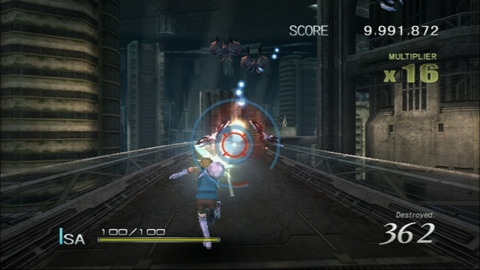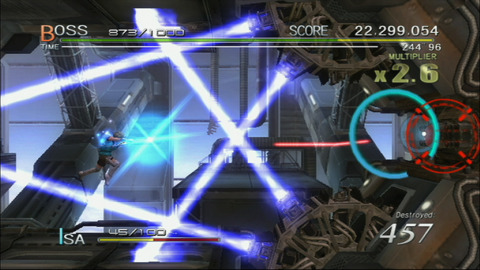
Star Successor plays with the basic on-rails shooter concept that drove games like Space Harrier and Panzer Dragoon, allowing you to move around the area of the screen while the game assumes control of both the movement through the environment as well as the perspective of the camera. Star Successor's dynamic use of the camera is one of its greatest strengths, allowing it to transition, at will, between horizontal, vertical, and behind-the-back perspectives. The wild variety of environments play up this aspect, and like a good roller coaster ride, it can make for a delightfully disorienting experience as floors turn into ceilings and up becomes sideways. Regardless of its fancy footwork, this is still a shooter, so you'll logically spend most of your time in Star Successor shooting, usually while simultaneously trying to dodge a near-constant barrage of incoming fire. You've also got a melee attack should enemies get too close, as well as a powered-up shot that's good for crowd control or particularly stubborn enemies.

So, a thing about boss battles in Star Successor. There are a lot of them. Like, I very probably spent more time battling bosses than I did the cannon fodder in between those big encounters. Treasure's not afraid to just stack one screen-filling, camera-spinning boss fight right after another, cleanse the palate with something that more closely approximates a traditional shooter level, and then on to another boss fight. It's something that contributes significantly to the game's relentlessness, which is itself a characteristic that suits a shooter particularly well. Also, the bosses are almost consistently nuts, with a variety that borders on the psychedelic. You'll do battle with a drippy, orifice-covered, building-sized biomechanical nightmare; a giant flying sand-tiger-eagle monster; an impossibly huge, robot-and-missile-spewing super battleship that floats in lava; a mind-bogglingly complex space station draped in lasers; and a samurai-space-horse-god demon, to name just a few.

More than its length, though, I found myself underwhelmed by certain aspects of the game's presentation. For all its speed, Star Successor makes some noticeable sacrifices with the clarity of its textures and the level of detail in the environments, and much of the color in the game seems oddly desaturated as well. Usually you're moving too fast to notice, but it makes the already-stilted cutscenes that much more awkward. Some stiff voice work contributes to this as well, though the propulsive synthesizer soundtrack does its part in redeeming the overall sound design.
The past decade has been pretty lean for shooters, which have survived by pleasing the weird whims of an increasingly niche audience. If there's anyone that can bring the genre back on track, it's probably Treasure, and Sin & Punishment: Star Successor seems like a step in the right direction.